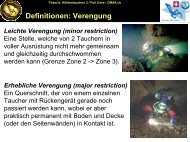cave diving and the nss - bei Swiss-Cave-Diving
cave diving and the nss - bei Swiss-Cave-Diving
cave diving and the nss - bei Swiss-Cave-Diving
Create successful ePaper yourself
Turn your PDF publications into a flip-book with our unique Google optimized e-Paper software.
10 CAVE DIVING COMMUNICATIONS<br />
urgent, you may not even<br />
need to perform <strong>the</strong> attention<br />
or emergency signals.<br />
You may only have<br />
to stop <strong>and</strong> turn side<br />
ways, <strong>and</strong> wait until you<br />
are sure your buddy is<br />
looking at you. Then you<br />
ei<strong>the</strong>r begin h<strong>and</strong> signing,<br />
or use your light to<br />
direct your buddy's attention<br />
to some feature of<br />
<strong>the</strong> <strong>cave</strong> you want him to<br />
examine. If, on <strong>the</strong> o<strong>the</strong>r<br />
h<strong>and</strong>, your message is<br />
very urgent or you're immobilized<br />
(e.g., entangled<br />
in <strong>the</strong> line), <strong>the</strong> attention<br />
or emergency flash<br />
should start him on his<br />
way towards you posthaste.<br />
If you're behind <strong>the</strong> diver you want to signal <strong>and</strong> his light is<br />
shining ahead on a wall, a good bet is to flash your light across his<br />
beam, since chances are that's where he's looking. If, on <strong>the</strong> o<strong>the</strong>r<br />
h<strong>and</strong>, you are in a system with dark walls which reflect very little<br />
light, or where <strong>the</strong>re are no visible walls at all, it may be more<br />
difficult to flash him down. If he is experienced <strong>and</strong> has his wits<br />
about him, <strong>the</strong> lead diver will be aware of <strong>the</strong> greater difficulty of<br />
seeing your attention-getting light signals. He will know that he<br />
must take it upon himself to turn around <strong>and</strong> look at you more often.<br />
Swimming through what appears to be a black void with no<br />
visible walls, floor, or ceiling, can be even more disorienting for <strong>the</strong><br />
lead diver h<strong>and</strong>ling a reel. He is encountering it first <strong>and</strong> doesn't<br />
even have <strong>the</strong> object orientation of dim rock shapes or ano<strong>the</strong>r<br />
diver to view. If it's a relatively deep void, he won't have his ears<br />
to clue him onto subtle depth changes, so he will have <strong>the</strong> added<br />
distraction of having to check his depth gauge fairly frequently, if<br />
not almost continuously. (Of course, if it's that big a void, <strong>the</strong>re<br />
probably isn't too much reason why you can't swim along side by<br />
side.)<br />
CAVE DIVING COMMUNICATIONS 11<br />
Limited visibility—<br />
<strong>and</strong> by that we mean<br />
anything from 30 feet, to<br />
30 inches, to 30 microns<br />
—poses its own problems<br />
for visual communications.<br />
The poorer<br />
<strong>the</strong> visibility, <strong>the</strong> closer<br />
you must be to <strong>the</strong> line<br />
<strong>and</strong>, within reason, to<br />
your buddy. Even with<br />
visibility measured in<br />
feet, at close quarters<br />
your buddy's light will<br />
help guide you to him,<br />
where you can communicate<br />
with h<strong>and</strong> signals, or<br />
failing that, with touch<br />
contact.<br />
Assuming that you<br />
are not completely silted out <strong>and</strong> still have sufficient visibility to be<br />
able to see your buddy's fingers, <strong>the</strong> next step in communicating<br />
more complicated messages is usually h<strong>and</strong> signals.















